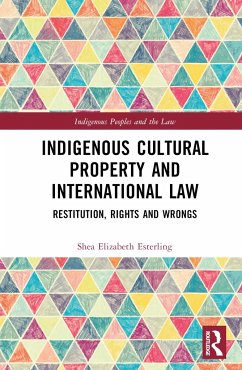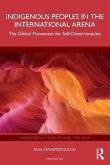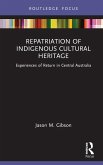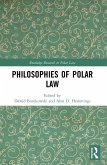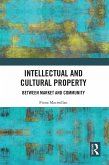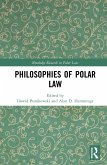Shea Elizabeth Esterling
Indigenous Cultural Property and International Law
Restitution, Rights and Wrongs
Shea Elizabeth Esterling
Indigenous Cultural Property and International Law
Restitution, Rights and Wrongs
- Gebundenes Buch
- Merkliste
- Auf die Merkliste
- Bewerten Bewerten
- Teilen
- Produkt teilen
- Produkterinnerung
- Produkterinnerung
Examining the restitution of cultural property to Indigenous Peoples in human rights law, this book offers a detailed analysis of the opportunities and constraints of international law as a tool of resistance and social transformation for marginalized groups.
In accordance with an increasing insistence on respect for diverse cultures, and through their own international mobilization, Indigenous Peoples have participated in the construction of a distinct human rights framework. Significant academic inquiry has focused on the substantive gains made by Indigenous Peoples in this context, along…mehr
Andere Kunden interessierten sich auch für
![Indigenous Peoples in the International Arena Indigenous Peoples in the International Arena]() Elsa StamatopoulouIndigenous Peoples in the International Arena38,99 €
Elsa StamatopoulouIndigenous Peoples in the International Arena38,99 €![Repatriation of Indigenous Cultural Heritage Repatriation of Indigenous Cultural Heritage]() Jason M. GibsonRepatriation of Indigenous Cultural Heritage21,99 €
Jason M. GibsonRepatriation of Indigenous Cultural Heritage21,99 €![Repatriation of Indigenous Cultural Heritage Repatriation of Indigenous Cultural Heritage]() Jason M. GibsonRepatriation of Indigenous Cultural Heritage58,99 €
Jason M. GibsonRepatriation of Indigenous Cultural Heritage58,99 €![Cultural Heritage Rights Cultural Heritage Rights]() Anthony J. ConnollyCultural Heritage Rights41,99 €
Anthony J. ConnollyCultural Heritage Rights41,99 €![Philosophies of Polar Law Philosophies of Polar Law]() Philosophies of Polar Law40,99 €
Philosophies of Polar Law40,99 €![Intellectual and Cultural Property Intellectual and Cultural Property]() Fiona MacmillanIntellectual and Cultural Property42,99 €
Fiona MacmillanIntellectual and Cultural Property42,99 €![Philosophies of Polar Law Philosophies of Polar Law]() Philosophies of Polar Law142,99 €
Philosophies of Polar Law142,99 €-
-
-
Examining the restitution of cultural property to Indigenous Peoples in human rights law, this book offers a detailed analysis of the opportunities and constraints of international law as a tool of resistance and social transformation for marginalized groups.
In accordance with an increasing insistence on respect for diverse cultures, and through their own international mobilization, Indigenous Peoples have participated in the construction of a distinct human rights framework. Significant academic inquiry has focused on the substantive gains made by Indigenous Peoples in this context, along with its impact on a body of law that had previously denied Indigenous Peoples a basis for claims to their own cultural materials and practices. Accordingly, this book acknowledges that Indigenous Peoples, as non-state actors, have generated greater substantive and procedural legitimacy in human rights law making. Offering normative insights into the participation of non-state actors in international law making, however, it also demonstrates that, despite their significant role in constructing the legal framework of human rights in the 21st century, the participation of Indigenous Peoples continues to be structurally limited.
With its interdisciplinary approach to the field, this book will appeal to scholars and students in the fields of law, politics, anthropology and indigenous studies.
In accordance with an increasing insistence on respect for diverse cultures, and through their own international mobilization, Indigenous Peoples have participated in the construction of a distinct human rights framework. Significant academic inquiry has focused on the substantive gains made by Indigenous Peoples in this context, along with its impact on a body of law that had previously denied Indigenous Peoples a basis for claims to their own cultural materials and practices. Accordingly, this book acknowledges that Indigenous Peoples, as non-state actors, have generated greater substantive and procedural legitimacy in human rights law making. Offering normative insights into the participation of non-state actors in international law making, however, it also demonstrates that, despite their significant role in constructing the legal framework of human rights in the 21st century, the participation of Indigenous Peoples continues to be structurally limited.
With its interdisciplinary approach to the field, this book will appeal to scholars and students in the fields of law, politics, anthropology and indigenous studies.
Produktdetails
- Produktdetails
- Indigenous Peoples and the Law
- Verlag: Routledge / Taylor & Francis
- Seitenzahl: 268
- Erscheinungstermin: 23. Oktober 2023
- Englisch
- Abmessung: 240mm x 161mm x 19mm
- Gewicht: 521g
- ISBN-13: 9780367182007
- ISBN-10: 0367182009
- Artikelnr.: 67825116
- Herstellerkennzeichnung
- Libri GmbH
- Europaallee 1
- 36244 Bad Hersfeld
- gpsr@libri.de
- Indigenous Peoples and the Law
- Verlag: Routledge / Taylor & Francis
- Seitenzahl: 268
- Erscheinungstermin: 23. Oktober 2023
- Englisch
- Abmessung: 240mm x 161mm x 19mm
- Gewicht: 521g
- ISBN-13: 9780367182007
- ISBN-10: 0367182009
- Artikelnr.: 67825116
- Herstellerkennzeichnung
- Libri GmbH
- Europaallee 1
- 36244 Bad Hersfeld
- gpsr@libri.de
Shea Elizabeth Esterling is Senior Lecturer in the Faculty of Law at the University of Canterbury in Christchurch, New Zealand; a Fellow of the Higher Education Academy; and Co-Chair of the American Society of International Law Rights of Indigenous Peoples Interest Group.
Acknowledgments xi
1 Introductions 1
On Indigenous Cultural Property and Restitution 1
On the Repatriation Debate 3
On Aims and Arguments 4
On Location 8
On Method 9
On Organization 11
2 A Textual Analysis: Article 11 of the United Nations Declaration on the Rights of Indigenous Peoples 18
Introduction 18
I. Situating Indigenous Peoples and Claims for Cultural Property: A Brief History of Indigenous Rights as Human Rights 21
II. The UN Declaration on the Rights of Indigenous Peoples and Indigenous Cultural Heritage 27
A Distinctive Identity, a Distinctive Space: The UN Declaration on the Rights of Indigenous Peoples 27
The Long and Winding Road to the UNDRIP: A Soft Law Success 28
A Sui Generis Scheme: UNDRIP and Indigenous Cultural Heritage 33
A Tale of Terminology: Cultural Heritage Versus Cultural Property 35
III. A Textual Analysis: Article 11, Indigenous Cultural Property, Redress and the UNDRIP 40
Article 11: A Cultural Right in Cultural Integrity 40
Article 11: An Application 44
IV. The International Legal Framework for the Protection of Cultural Property 54
An Indigenous View: The UNESCO Convention 1970 56
An Indigenous View: The UNIDROIT Convention 1995 60
Conclusions 64
3 A Purposive Analysis: Article 11 of the United Nations Declaration on the Rights of Indigenous Peoples 73
Introduction 73
I. One Step Forward, One Step Back: A Sui Generis Right Gained, a Sui Generis Right Lost 74
A Shadow of a Draft: Article 11 and Its Retrogression 74
Right to Restitution: A Drafting History 75
II. A Sui Generis Right Lost: Human Rights and the Restitution of Cultural Property 82
Article 27: A Cultural Right 83
Article 27: Limits 86
Article 1: The Right to Self-Determination 89
A Minimalist Approach: The Approach of States to Self-Determination 91
A Minimalist Approach and the Application of Self- Determination to Indigenous Peoples: The Beneficiary Debate 91
A Minimalist Approach and the Modality of Self- Determination Available to Indigenous Peoples: External and Internal Self-Determination 93
A Minimalist Approach: Self-Determination Within the UNDRIP 95
A Maximalist Approach: The Approach of Indigenous Peoples to Self-Determination 107
Conclusions 116
4 A Contextual Analysis: Article 11 of the United Nations Declaration on the Rights of Indigenous Peoples 122
Introduction 122
I. The Disruption of Property Rights, Article 11 and the Restitution of Cultural Property 123
Western and Indigenous Conceptions of Property Rights 123
II. Collective Rights, Article 11 and the Restitution of Cultural Property 132
ICCPR Article 27 and Collective Rights 133
The UNDRIP and Collective Rights 136
III. Sovereignty, Article 11 and the Restitution of Cultural Property 140
Sovereignty 140
Article 11 and Sovereignty: Cultural Property and Its Redress 142
Voluntary Restitution of Cultural Property 148
IV. One Step Forward, Two Steps Back: Article 11 and the Disempowerment of Cultural Rights and Temporal Uncertainty 151
Decoupling Restitution and Cultural Integrity: Disempowering Cultural Rights 152
Decoupling Restitution and Cultural Integrity: Temporal Uncertainty 155
Non-retroactivity 156
Legal Status and the Temporal Scope of the Redress of Cultural Property Under International Law 159
Article 11 and Temporal Scope 161
Conclusions: Unintended Consequences and Indigenous Participation in International Law Making 170
5 Discursive Limits: Article 11 of the United Nations Declaration on the Rights of Indigenous Peoples and Human Rights Law 180
Introduction 180
I. Essentialism as Categorization and Human Rights: Indigenous Identity 182
Essentialism as Categorization: Indigenous Identity and Restitution 185
Essentialism as Categorization: Indigenous Identity and the Restitution of Cultural Property 189
II. Essentialism as Categorization and Human Rights: Indigenous Claims 192
Essentialism as Categorization: Indigenous Claims and the Restitution of Cultural Property 195
III. Essentialism as Reification and Human Rights: Unstrategic and Strategic Approaches 198
Essentialism as Reification and Cultural Property: An Unstrategic Approach 199
Essentialism as Reification and Human Rights: Fixing Identity and Culture 201
Essentialism as Reification and the Restitution of Cultural Property: A Strategic Approach 204
IV. Conclusion: Downsides, Unintended Consequences and the Human Rights Discourse 215
6 Some Conclusions 227
Conclusion 245
Index 249
Acknowledgments xi
1 Introductions 1
On Indigenous Cultural Property and Restitution 1
On the Repatriation Debate 3
On Aims and Arguments 4
On Location 8
On Method 9
On Organization 11
2 A Textual Analysis: Article 11 of the United Nations Declaration on the
Rights of Indigenous Peoples 18
Introduction 18
I. Situating Indigenous Peoples and Claims for Cultural Property: A Brief
History of Indigenous Rights as Human Rights 21
II. The UN Declaration on the Rights of Indigenous Peoples and Indigenous
Cultural Heritage 27
A Distinctive Identity, a Distinctive Space: The UN Declaration on the
Rights of Indigenous Peoples 27
The Long and Winding Road to the UNDRIP: A Soft Law Success 28
A Sui Generis Scheme: UNDRIP and Indigenous Cultural Heritage 33
A Tale of Terminology: Cultural Heritage Versus Cultural Property 35
III. A Textual Analysis: Article 11, Indigenous Cultural Property, Redress
and the UNDRIP 40
Article 11: A Cultural Right in Cultural Integrity 40
Article 11: An Application 44
IV. The International Legal Framework for the Protection of Cultural
Property 54
An Indigenous View: The UNESCO Convention 1970 56
An Indigenous View: The UNIDROIT Convention 1995 60
Conclusions 64
3 A Purposive Analysis: Article 11 of the United Nations Declaration on the
Rights of Indigenous Peoples 73
Introduction 73
I. One Step Forward, One Step Back: A Sui Generis Right Gained, a Sui
Generis Right Lost 74
A Shadow of a Draft: Article 11 and Its Retrogression 74
Right to Restitution: A Drafting History 75
II. A Sui Generis Right Lost: Human Rights and the Restitution of Cultural
Property 82
Article 27: A Cultural Right 83
Article 27: Limits 86
Article 1: The Right to Self-Determination 89
A Minimalist Approach: The Approach of States to Self-Determination 91
A Minimalist Approach and the Application of Self- Determination to
Indigenous Peoples: The Beneficiary Debate 91
A Minimalist Approach and the Modality of Self- Determination Available to
Indigenous Peoples: External and Internal Self-Determination 93
A Minimalist Approach: Self-Determination Within the UNDRIP 95
A Maximalist Approach: The Approach of Indigenous Peoples to
Self-Determination 107
Conclusions 116
4 A Contextual Analysis: Article 11 of the United Nations Declaration on
the Rights of Indigenous Peoples 122
Introduction 122
I. The Disruption of Property Rights, Article 11 and the Restitution of
Cultural Property 123
Western and Indigenous Conceptions of Property Rights 123
II. Collective Rights, Article 11 and the Restitution of Cultural Property
132
ICCPR Article 27 and Collective Rights 133
The UNDRIP and Collective Rights 136
III. Sovereignty, Article 11 and the Restitution of Cultural Property 140
Sovereignty 140
Article 11 and Sovereignty: Cultural Property and Its Redress 142
Voluntary Restitution of Cultural Property 148
IV. One Step Forward, Two Steps Back: Article 11 and the Disempowerment of
Cultural Rights and Temporal Uncertainty 151
Decoupling Restitution and Cultural Integrity: Disempowering Cultural
Rights 152
Decoupling Restitution and Cultural Integrity: Temporal Uncertainty 155
Non-retroactivity 156
Legal Status and the Temporal Scope of the Redress of Cultural Property
Under International Law 159
Article 11 and Temporal Scope 161
Conclusions: Unintended Consequences and Indigenous Participation in
International Law Making 170
5 Discursive Limits: Article 11 of the United Nations Declaration on the
Rights of Indigenous Peoples and Human Rights Law 180
Introduction 180
I. Essentialism as Categorization and Human Rights: Indigenous Identity 182
Essentialism as Categorization: Indigenous Identity and Restitution 185
Essentialism as Categorization: Indigenous Identity and the Restitution of
Cultural Property 189
II. Essentialism as Categorization and Human Rights: Indigenous Claims 192
Essentialism as Categorization: Indigenous Claims and the Restitution of
Cultural Property 195
III. Essentialism as Reification and Human Rights: Unstrategic and
Strategic Approaches 198
Essentialism as Reification and Cultural Property: An Unstrategic Approach
199
Essentialism as Reification and Human Rights: Fixing Identity and Culture
201
Essentialism as Reification and the Restitution of Cultural Property: A
Strategic Approach 204
IV. Conclusion: Downsides, Unintended Consequences and the Human Rights
Discourse 215
6 Some Conclusions 227
Conclusion 245
Index 249
1 Introductions 1
On Indigenous Cultural Property and Restitution 1
On the Repatriation Debate 3
On Aims and Arguments 4
On Location 8
On Method 9
On Organization 11
2 A Textual Analysis: Article 11 of the United Nations Declaration on the
Rights of Indigenous Peoples 18
Introduction 18
I. Situating Indigenous Peoples and Claims for Cultural Property: A Brief
History of Indigenous Rights as Human Rights 21
II. The UN Declaration on the Rights of Indigenous Peoples and Indigenous
Cultural Heritage 27
A Distinctive Identity, a Distinctive Space: The UN Declaration on the
Rights of Indigenous Peoples 27
The Long and Winding Road to the UNDRIP: A Soft Law Success 28
A Sui Generis Scheme: UNDRIP and Indigenous Cultural Heritage 33
A Tale of Terminology: Cultural Heritage Versus Cultural Property 35
III. A Textual Analysis: Article 11, Indigenous Cultural Property, Redress
and the UNDRIP 40
Article 11: A Cultural Right in Cultural Integrity 40
Article 11: An Application 44
IV. The International Legal Framework for the Protection of Cultural
Property 54
An Indigenous View: The UNESCO Convention 1970 56
An Indigenous View: The UNIDROIT Convention 1995 60
Conclusions 64
3 A Purposive Analysis: Article 11 of the United Nations Declaration on the
Rights of Indigenous Peoples 73
Introduction 73
I. One Step Forward, One Step Back: A Sui Generis Right Gained, a Sui
Generis Right Lost 74
A Shadow of a Draft: Article 11 and Its Retrogression 74
Right to Restitution: A Drafting History 75
II. A Sui Generis Right Lost: Human Rights and the Restitution of Cultural
Property 82
Article 27: A Cultural Right 83
Article 27: Limits 86
Article 1: The Right to Self-Determination 89
A Minimalist Approach: The Approach of States to Self-Determination 91
A Minimalist Approach and the Application of Self- Determination to
Indigenous Peoples: The Beneficiary Debate 91
A Minimalist Approach and the Modality of Self- Determination Available to
Indigenous Peoples: External and Internal Self-Determination 93
A Minimalist Approach: Self-Determination Within the UNDRIP 95
A Maximalist Approach: The Approach of Indigenous Peoples to
Self-Determination 107
Conclusions 116
4 A Contextual Analysis: Article 11 of the United Nations Declaration on
the Rights of Indigenous Peoples 122
Introduction 122
I. The Disruption of Property Rights, Article 11 and the Restitution of
Cultural Property 123
Western and Indigenous Conceptions of Property Rights 123
II. Collective Rights, Article 11 and the Restitution of Cultural Property
132
ICCPR Article 27 and Collective Rights 133
The UNDRIP and Collective Rights 136
III. Sovereignty, Article 11 and the Restitution of Cultural Property 140
Sovereignty 140
Article 11 and Sovereignty: Cultural Property and Its Redress 142
Voluntary Restitution of Cultural Property 148
IV. One Step Forward, Two Steps Back: Article 11 and the Disempowerment of
Cultural Rights and Temporal Uncertainty 151
Decoupling Restitution and Cultural Integrity: Disempowering Cultural
Rights 152
Decoupling Restitution and Cultural Integrity: Temporal Uncertainty 155
Non-retroactivity 156
Legal Status and the Temporal Scope of the Redress of Cultural Property
Under International Law 159
Article 11 and Temporal Scope 161
Conclusions: Unintended Consequences and Indigenous Participation in
International Law Making 170
5 Discursive Limits: Article 11 of the United Nations Declaration on the
Rights of Indigenous Peoples and Human Rights Law 180
Introduction 180
I. Essentialism as Categorization and Human Rights: Indigenous Identity 182
Essentialism as Categorization: Indigenous Identity and Restitution 185
Essentialism as Categorization: Indigenous Identity and the Restitution of
Cultural Property 189
II. Essentialism as Categorization and Human Rights: Indigenous Claims 192
Essentialism as Categorization: Indigenous Claims and the Restitution of
Cultural Property 195
III. Essentialism as Reification and Human Rights: Unstrategic and
Strategic Approaches 198
Essentialism as Reification and Cultural Property: An Unstrategic Approach
199
Essentialism as Reification and Human Rights: Fixing Identity and Culture
201
Essentialism as Reification and the Restitution of Cultural Property: A
Strategic Approach 204
IV. Conclusion: Downsides, Unintended Consequences and the Human Rights
Discourse 215
6 Some Conclusions 227
Conclusion 245
Index 249
Acknowledgments xi
1 Introductions 1
On Indigenous Cultural Property and Restitution 1
On the Repatriation Debate 3
On Aims and Arguments 4
On Location 8
On Method 9
On Organization 11
2 A Textual Analysis: Article 11 of the United Nations Declaration on the Rights of Indigenous Peoples 18
Introduction 18
I. Situating Indigenous Peoples and Claims for Cultural Property: A Brief History of Indigenous Rights as Human Rights 21
II. The UN Declaration on the Rights of Indigenous Peoples and Indigenous Cultural Heritage 27
A Distinctive Identity, a Distinctive Space: The UN Declaration on the Rights of Indigenous Peoples 27
The Long and Winding Road to the UNDRIP: A Soft Law Success 28
A Sui Generis Scheme: UNDRIP and Indigenous Cultural Heritage 33
A Tale of Terminology: Cultural Heritage Versus Cultural Property 35
III. A Textual Analysis: Article 11, Indigenous Cultural Property, Redress and the UNDRIP 40
Article 11: A Cultural Right in Cultural Integrity 40
Article 11: An Application 44
IV. The International Legal Framework for the Protection of Cultural Property 54
An Indigenous View: The UNESCO Convention 1970 56
An Indigenous View: The UNIDROIT Convention 1995 60
Conclusions 64
3 A Purposive Analysis: Article 11 of the United Nations Declaration on the Rights of Indigenous Peoples 73
Introduction 73
I. One Step Forward, One Step Back: A Sui Generis Right Gained, a Sui Generis Right Lost 74
A Shadow of a Draft: Article 11 and Its Retrogression 74
Right to Restitution: A Drafting History 75
II. A Sui Generis Right Lost: Human Rights and the Restitution of Cultural Property 82
Article 27: A Cultural Right 83
Article 27: Limits 86
Article 1: The Right to Self-Determination 89
A Minimalist Approach: The Approach of States to Self-Determination 91
A Minimalist Approach and the Application of Self- Determination to Indigenous Peoples: The Beneficiary Debate 91
A Minimalist Approach and the Modality of Self- Determination Available to Indigenous Peoples: External and Internal Self-Determination 93
A Minimalist Approach: Self-Determination Within the UNDRIP 95
A Maximalist Approach: The Approach of Indigenous Peoples to Self-Determination 107
Conclusions 116
4 A Contextual Analysis: Article 11 of the United Nations Declaration on the Rights of Indigenous Peoples 122
Introduction 122
I. The Disruption of Property Rights, Article 11 and the Restitution of Cultural Property 123
Western and Indigenous Conceptions of Property Rights 123
II. Collective Rights, Article 11 and the Restitution of Cultural Property 132
ICCPR Article 27 and Collective Rights 133
The UNDRIP and Collective Rights 136
III. Sovereignty, Article 11 and the Restitution of Cultural Property 140
Sovereignty 140
Article 11 and Sovereignty: Cultural Property and Its Redress 142
Voluntary Restitution of Cultural Property 148
IV. One Step Forward, Two Steps Back: Article 11 and the Disempowerment of Cultural Rights and Temporal Uncertainty 151
Decoupling Restitution and Cultural Integrity: Disempowering Cultural Rights 152
Decoupling Restitution and Cultural Integrity: Temporal Uncertainty 155
Non-retroactivity 156
Legal Status and the Temporal Scope of the Redress of Cultural Property Under International Law 159
Article 11 and Temporal Scope 161
Conclusions: Unintended Consequences and Indigenous Participation in International Law Making 170
5 Discursive Limits: Article 11 of the United Nations Declaration on the Rights of Indigenous Peoples and Human Rights Law 180
Introduction 180
I. Essentialism as Categorization and Human Rights: Indigenous Identity 182
Essentialism as Categorization: Indigenous Identity and Restitution 185
Essentialism as Categorization: Indigenous Identity and the Restitution of Cultural Property 189
II. Essentialism as Categorization and Human Rights: Indigenous Claims 192
Essentialism as Categorization: Indigenous Claims and the Restitution of Cultural Property 195
III. Essentialism as Reification and Human Rights: Unstrategic and Strategic Approaches 198
Essentialism as Reification and Cultural Property: An Unstrategic Approach 199
Essentialism as Reification and Human Rights: Fixing Identity and Culture 201
Essentialism as Reification and the Restitution of Cultural Property: A Strategic Approach 204
IV. Conclusion: Downsides, Unintended Consequences and the Human Rights Discourse 215
6 Some Conclusions 227
Conclusion 245
Index 249
Acknowledgments xi
1 Introductions 1
On Indigenous Cultural Property and Restitution 1
On the Repatriation Debate 3
On Aims and Arguments 4
On Location 8
On Method 9
On Organization 11
2 A Textual Analysis: Article 11 of the United Nations Declaration on the
Rights of Indigenous Peoples 18
Introduction 18
I. Situating Indigenous Peoples and Claims for Cultural Property: A Brief
History of Indigenous Rights as Human Rights 21
II. The UN Declaration on the Rights of Indigenous Peoples and Indigenous
Cultural Heritage 27
A Distinctive Identity, a Distinctive Space: The UN Declaration on the
Rights of Indigenous Peoples 27
The Long and Winding Road to the UNDRIP: A Soft Law Success 28
A Sui Generis Scheme: UNDRIP and Indigenous Cultural Heritage 33
A Tale of Terminology: Cultural Heritage Versus Cultural Property 35
III. A Textual Analysis: Article 11, Indigenous Cultural Property, Redress
and the UNDRIP 40
Article 11: A Cultural Right in Cultural Integrity 40
Article 11: An Application 44
IV. The International Legal Framework for the Protection of Cultural
Property 54
An Indigenous View: The UNESCO Convention 1970 56
An Indigenous View: The UNIDROIT Convention 1995 60
Conclusions 64
3 A Purposive Analysis: Article 11 of the United Nations Declaration on the
Rights of Indigenous Peoples 73
Introduction 73
I. One Step Forward, One Step Back: A Sui Generis Right Gained, a Sui
Generis Right Lost 74
A Shadow of a Draft: Article 11 and Its Retrogression 74
Right to Restitution: A Drafting History 75
II. A Sui Generis Right Lost: Human Rights and the Restitution of Cultural
Property 82
Article 27: A Cultural Right 83
Article 27: Limits 86
Article 1: The Right to Self-Determination 89
A Minimalist Approach: The Approach of States to Self-Determination 91
A Minimalist Approach and the Application of Self- Determination to
Indigenous Peoples: The Beneficiary Debate 91
A Minimalist Approach and the Modality of Self- Determination Available to
Indigenous Peoples: External and Internal Self-Determination 93
A Minimalist Approach: Self-Determination Within the UNDRIP 95
A Maximalist Approach: The Approach of Indigenous Peoples to
Self-Determination 107
Conclusions 116
4 A Contextual Analysis: Article 11 of the United Nations Declaration on
the Rights of Indigenous Peoples 122
Introduction 122
I. The Disruption of Property Rights, Article 11 and the Restitution of
Cultural Property 123
Western and Indigenous Conceptions of Property Rights 123
II. Collective Rights, Article 11 and the Restitution of Cultural Property
132
ICCPR Article 27 and Collective Rights 133
The UNDRIP and Collective Rights 136
III. Sovereignty, Article 11 and the Restitution of Cultural Property 140
Sovereignty 140
Article 11 and Sovereignty: Cultural Property and Its Redress 142
Voluntary Restitution of Cultural Property 148
IV. One Step Forward, Two Steps Back: Article 11 and the Disempowerment of
Cultural Rights and Temporal Uncertainty 151
Decoupling Restitution and Cultural Integrity: Disempowering Cultural
Rights 152
Decoupling Restitution and Cultural Integrity: Temporal Uncertainty 155
Non-retroactivity 156
Legal Status and the Temporal Scope of the Redress of Cultural Property
Under International Law 159
Article 11 and Temporal Scope 161
Conclusions: Unintended Consequences and Indigenous Participation in
International Law Making 170
5 Discursive Limits: Article 11 of the United Nations Declaration on the
Rights of Indigenous Peoples and Human Rights Law 180
Introduction 180
I. Essentialism as Categorization and Human Rights: Indigenous Identity 182
Essentialism as Categorization: Indigenous Identity and Restitution 185
Essentialism as Categorization: Indigenous Identity and the Restitution of
Cultural Property 189
II. Essentialism as Categorization and Human Rights: Indigenous Claims 192
Essentialism as Categorization: Indigenous Claims and the Restitution of
Cultural Property 195
III. Essentialism as Reification and Human Rights: Unstrategic and
Strategic Approaches 198
Essentialism as Reification and Cultural Property: An Unstrategic Approach
199
Essentialism as Reification and Human Rights: Fixing Identity and Culture
201
Essentialism as Reification and the Restitution of Cultural Property: A
Strategic Approach 204
IV. Conclusion: Downsides, Unintended Consequences and the Human Rights
Discourse 215
6 Some Conclusions 227
Conclusion 245
Index 249
1 Introductions 1
On Indigenous Cultural Property and Restitution 1
On the Repatriation Debate 3
On Aims and Arguments 4
On Location 8
On Method 9
On Organization 11
2 A Textual Analysis: Article 11 of the United Nations Declaration on the
Rights of Indigenous Peoples 18
Introduction 18
I. Situating Indigenous Peoples and Claims for Cultural Property: A Brief
History of Indigenous Rights as Human Rights 21
II. The UN Declaration on the Rights of Indigenous Peoples and Indigenous
Cultural Heritage 27
A Distinctive Identity, a Distinctive Space: The UN Declaration on the
Rights of Indigenous Peoples 27
The Long and Winding Road to the UNDRIP: A Soft Law Success 28
A Sui Generis Scheme: UNDRIP and Indigenous Cultural Heritage 33
A Tale of Terminology: Cultural Heritage Versus Cultural Property 35
III. A Textual Analysis: Article 11, Indigenous Cultural Property, Redress
and the UNDRIP 40
Article 11: A Cultural Right in Cultural Integrity 40
Article 11: An Application 44
IV. The International Legal Framework for the Protection of Cultural
Property 54
An Indigenous View: The UNESCO Convention 1970 56
An Indigenous View: The UNIDROIT Convention 1995 60
Conclusions 64
3 A Purposive Analysis: Article 11 of the United Nations Declaration on the
Rights of Indigenous Peoples 73
Introduction 73
I. One Step Forward, One Step Back: A Sui Generis Right Gained, a Sui
Generis Right Lost 74
A Shadow of a Draft: Article 11 and Its Retrogression 74
Right to Restitution: A Drafting History 75
II. A Sui Generis Right Lost: Human Rights and the Restitution of Cultural
Property 82
Article 27: A Cultural Right 83
Article 27: Limits 86
Article 1: The Right to Self-Determination 89
A Minimalist Approach: The Approach of States to Self-Determination 91
A Minimalist Approach and the Application of Self- Determination to
Indigenous Peoples: The Beneficiary Debate 91
A Minimalist Approach and the Modality of Self- Determination Available to
Indigenous Peoples: External and Internal Self-Determination 93
A Minimalist Approach: Self-Determination Within the UNDRIP 95
A Maximalist Approach: The Approach of Indigenous Peoples to
Self-Determination 107
Conclusions 116
4 A Contextual Analysis: Article 11 of the United Nations Declaration on
the Rights of Indigenous Peoples 122
Introduction 122
I. The Disruption of Property Rights, Article 11 and the Restitution of
Cultural Property 123
Western and Indigenous Conceptions of Property Rights 123
II. Collective Rights, Article 11 and the Restitution of Cultural Property
132
ICCPR Article 27 and Collective Rights 133
The UNDRIP and Collective Rights 136
III. Sovereignty, Article 11 and the Restitution of Cultural Property 140
Sovereignty 140
Article 11 and Sovereignty: Cultural Property and Its Redress 142
Voluntary Restitution of Cultural Property 148
IV. One Step Forward, Two Steps Back: Article 11 and the Disempowerment of
Cultural Rights and Temporal Uncertainty 151
Decoupling Restitution and Cultural Integrity: Disempowering Cultural
Rights 152
Decoupling Restitution and Cultural Integrity: Temporal Uncertainty 155
Non-retroactivity 156
Legal Status and the Temporal Scope of the Redress of Cultural Property
Under International Law 159
Article 11 and Temporal Scope 161
Conclusions: Unintended Consequences and Indigenous Participation in
International Law Making 170
5 Discursive Limits: Article 11 of the United Nations Declaration on the
Rights of Indigenous Peoples and Human Rights Law 180
Introduction 180
I. Essentialism as Categorization and Human Rights: Indigenous Identity 182
Essentialism as Categorization: Indigenous Identity and Restitution 185
Essentialism as Categorization: Indigenous Identity and the Restitution of
Cultural Property 189
II. Essentialism as Categorization and Human Rights: Indigenous Claims 192
Essentialism as Categorization: Indigenous Claims and the Restitution of
Cultural Property 195
III. Essentialism as Reification and Human Rights: Unstrategic and
Strategic Approaches 198
Essentialism as Reification and Cultural Property: An Unstrategic Approach
199
Essentialism as Reification and Human Rights: Fixing Identity and Culture
201
Essentialism as Reification and the Restitution of Cultural Property: A
Strategic Approach 204
IV. Conclusion: Downsides, Unintended Consequences and the Human Rights
Discourse 215
6 Some Conclusions 227
Conclusion 245
Index 249

